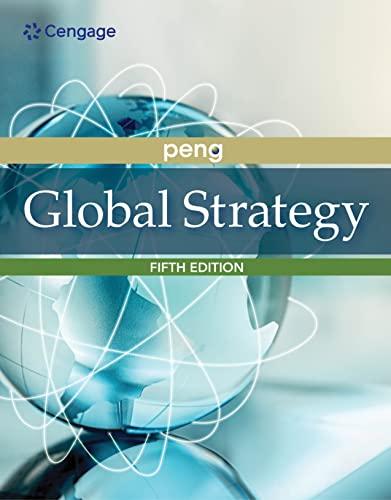Leveraging excellent engineering, German machine toolmakers are world leaders in their industry. As Chinas industrialization takes off,
Question:
Leveraging excellent engineering, German machine toolmakers are world leaders in their industry. As China’s industrialization takes off, they are often sought after in newly built factories that make cars and electronics.
However, not all German-engineered machines sold well in China. Schenck, a division of Dürr, produced in Germany one of the best balancing machines for armatures (small engines), achieving world-leading performance in accuracy and speed by balancing an armature in less than five seconds. Customers in developed economies appreciated the highly automated machine that helped to eliminate manual labor. Yet for several years after its founding in the mid-1990s, its Chinese subsidiary, Schenck Shanghai Machinery (SSM), failed to sell a single one of these excellent machines.
China-based manufacturers considered the machine “over-engineered.” At a unit price of $550,000, it was too expensive.
Industrial customers’ main purchasing criteria were brand, price, quality, service, and delivery. Schenck had a very good brand name, and it sold expensive high quality machines in other segments in China. However, the delivery period for Schenck was longer than that for its competitors, as its machines were tailor-made and had to go through rigorous testing before delivery. In comparison, two Japanese rivals—DSK and Kokusai—served the “goodenough” market with machines manufactured in China priced at $110,000. They dominated the segment that SSM found difficult to penetrate. Overall, SSM’s cost base was too high, even after moving production to China.
The subsidiary leadership at SSM believed that there was a market in China for balancing machines for armatures if they were cost competitive. Yet serving the good-enough segment was not in line with Schenck’s global strategy, which focused on the premium segment, offering the best of German engineering. The subsidiary managers faced a difficult choice: Should they give up this market segment or take some action? If so, should they take the machine made in Germany and strip it down to the essentials? Or should they develop a new machine from scratch for China?
On its own initiative, SSM started to develop its own machine for China by forming a development team of five engineers in 2005. The team reached out to marketing staff familiar with potential local customers and to sourcing staff who could identify suitable suppliers in China. The work of this development team was kept low profile, without engaging corporate headquarters (HQ) or other units outside China. At that time, the subsidiary leadership believed that it would be difficult to convince HQ and engineers in Germany to develop a new machine for China. Only by developing a new machine first did the subsidiary leadership expect to be able to earn the support from Germany.
The Shanghai-based development team created a new machine entirely from local components. The subsidiary leadership presented its prototype to HQ. The subsidiary managers were somewhat anxious how HQ would react.
HQ generally did not favor adding lower-quality machines to Schenck’s product portfolio because of the potential damage to the brand image. The idea of a less sophisticated machine under the Schenck name conflicted with the positioning of Schenck. How would clients in Europe react if they learned that Schenck offered a similar machine in China at a much lower price? Moreover, HQ at that time did not have an in-depth understanding of the nuances of the China market, and Germany-based R&D teams had little trust in the ability of their China-based colleagues.
To ensure the subsidiary initiative was a success, SSM invested considerable efforts in communicating with HQ and R&D colleagues in Germany. SSM found that managing the relationship with HQ was less difficult than anticipated. Key players in Germany quickly realized that SSM’s approach was probably the right one for China. Essentially, the prototype convinced HQ that the China-based development team was both technically capable and savvy about the local context. On this basis, engineers from Germany and China worked together to finalize the development.
Once ready for market, the new product quickly secured orders. Customers were pleasantly surprised to see that Schenck was able to produce a machine suitable for the China market. Priced at the same level as the machines from DSK and Kokusai, the Schenck machine quickly attracted customers away from these Japanese rivals.
The new machine benefited not only from the reputation of Schenck, but also from SSM’s ability to provide a range of different machines and integrated solutions. Overall, SSM successfully built a leading position in the market for balancing machines for armatures in China, with a market share of 35%–40%. The products were also extensively exported, especially to Southeast Asia.
CASE DISCUSSION QUESTIONS:
1. From a resource-based view, what resources are needed to develop a machine for a distant market such as China? Are such resources most likely to be found at the HQ or subsidiary level?
2. What are the adaptations needed to compete in the good-enough market?
3. From the HQ’s perspective, what are the pros and cons of this subsidiary initiative? From SSM’s perspective, what are the pros and cons of this particular initiative?
Step by Step Answer:






